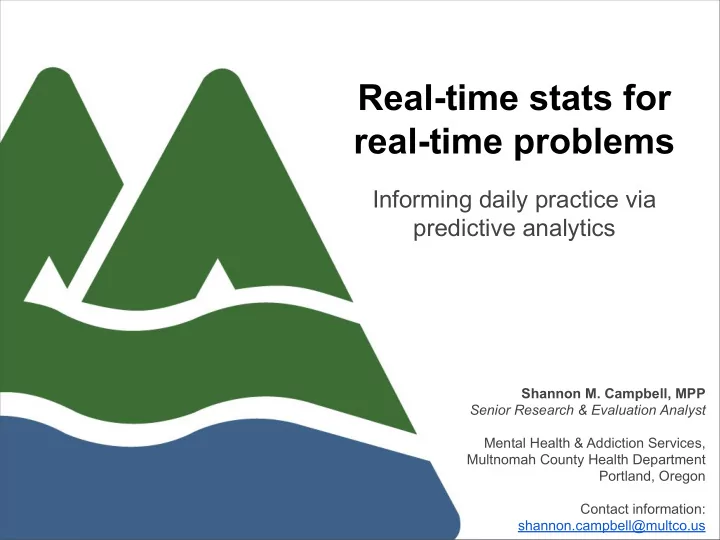

Real-time stats for real-time problems Informing daily practice via predictive analytics Shannon M. Campbell, MPP Senior Research & Evaluation Analyst Mental Health & Addiction Services, Multnomah County Health Department Portland, Oregon Contact information: shannon.campbell@multco.us
Real-time stats // Informing practice via predictive analytics Background ● Topic of interest: acute care ○ Inpatient psychiatric hospitalizations, behavioral health-driven ER visits, psychiatric emergency services (Unity) ○ Want to reduce acute care utilization by engaging clients in different levels of care that sustainably address their needs ● We follow up on hospitalizations and ED visits, we craft models showing what factors may impact readmission, but: ○ Can we predict which of our members are most at risk of impending psychiatric crisis before they occur, so that we can intervene in a more timely manner?
Real-time stats // Informing practice via predictive analytics Analysis ● Sample population: ○ Health Share members with 1+ year coverage and SPMI (severe and persistent mental illness), 1/1/15 to 6/30/17 ○ Result: 13,158 clients; 11,222 acute care events ● Data sources: ○ Healthcare claims, call center records, enrollment data ● Variables: ○ Front-line staff input on contributing factors, indicators of impending crisis, common traits of high utilizers, etc. ● Statistical analysis ○ Logistic regression and Cox multi-failure survival analysis
Real-time stats // Informing practice via predictive analytics Results ● Significant (non-demographic) variables: ○ No recent mental health outpatient history ○ Multiple SPMI-level diagnoses ○ History of substance use ○ Week with 2+ crisis line calls ○ History of homelessness/housing instability ○ Receiving SSI for disability ○ Healthcare encounters with respiratory issues as primary diagnosis ○ Healthcare encounters with pain issues as primary diagnosis
Real-time stats // Informing practice via predictive analytics But what do we do with it? ● From complex statistical model to something actionable ● Step 1: score creation ○ Use weights from statistical analysis to develop a formula ■ E.g., substance use history increases risk by 4.5 times → does this person have a substance use history in the last 12 months, yes or no? ● 4.5 * (1 or 0) + Weight2 * (1 or 0) + Weight3*(1 or 0)...=raw score ○ Scale to easily understood range--e.g., 0 to 10 ● Step 2: build the tool ○ Entire score can be automatically calculated from existing databases; stored procedure runs daily to update ○ Information available to staff via a Tableau dashboard
(demonstrate dashboard)
(demonstrate dashboard)
(demonstrate dashboard)
(demonstrate dashboard)
(demonstrate dashboard)
Real-time stats // Informing practice via predictive analytics Ethical considerations ● Responsibility to clearly communicate limits of analysis and principles of use ○ Only proactively offer help/services (never denying) ○ Respect for client autonomy ○ Not overriding clinical judgment ○ Human behavior too nuanced, messy to reduce to single number; intended as an additional data point, not the definitive word on a person or their life
Real-time stats // Informing practice via predictive analytics Many thanks to the following: ● Sivakrishna Yedlapelli and Shiva Sangireddy (Decision Support), for SQL development and for Tableau design (respectively)--automating the tool and creating a clean and accessible final product; ● Heath Barber , Lauren Castillo , and Jacob Mestman (Decision Support), for project management and support, ensuring the tool’s sustainability; ● Sarah Adelhart , Rochelle Pegel , David Sant (Utilization Management), Jessica Jacobsen , Rachel Phariss (Adult Care Coordination), and Leticia Sainz (Crisis Line), for providing subject matter expertise on acute care utilization and critical feedback on this project; ● Kelly Officer (Oregon Criminal Justice Commission), for providing the CJC’s risk prediction methodology as the starting point for this project; ● Devarshi Bajpai (Medicaid Plan Manager), for brainstorming this project and championing the work.
Real-time stats // Informing practice via predictive analytics “Real world” test ● If we used that scoring system on our entire population, how accurate would it be? ○ “Freeze” scores on specific date ○ Track actual events for next 30 days ○ Use score as main predictor
Recommend
More recommend